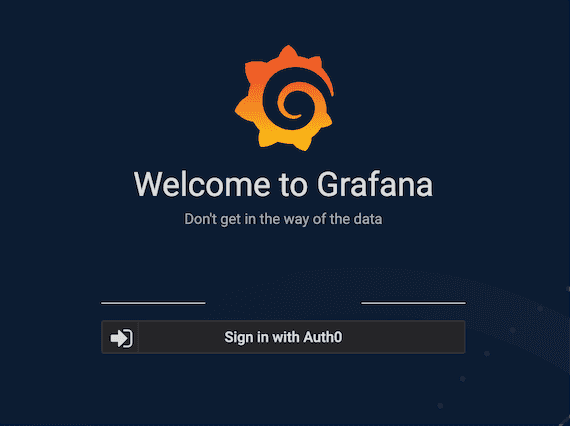Setting up OAuth for Grafana with Auth0
Auth0OAuthInfrastructure as CodeTerraformGrafana
If I say monitoring, the first thing that comes to mind is Prometheus. And its trusty sidekick, Grafana. Is it software engineering if you’re not continuously checking some dashboards? However, we don’t want to expose those dashboards on the public internet. That would be bad! In this post, I’m showing how to set up authentication for Grafana. I’m using Auth0 as an identity provider.
I wrote some time ago about setting up Auth0 with Terraform. Auth0 is an excellent product and a convenient way to set up authentication and authorization without handling the gory details. OAuth is the last thing you want to implement yourself.
I hadn’t checked my Auth0 account in a while, and honestly, I had forgotten many of the details. That’s one of the huge benefits of having the whole thing set up with Terraform. It is a lot easier to jump back, check the code, and understand what you need to add extra functionality. I don’t think the same can be said if you use the UI directly.
The flow
I’m going to configure Grafana to allow login through Auth0. I’m too lazy to handle user management, so in fact, I’m going to use Google users.
My Grafana instance is available under a domain such as https://grafana.mydomain.com. Technically, it sits behind an nginx acting as a reverse proxy. But that’s not relevant for our purposes.
Client and connection
As mentioned, I’m leveraging Google accounts through the auth0_connection resource. Additionally, I’m defining a new client (auth0_client) pointing to Grafana. The application type I need is a regular web application.
resource "auth0_client" "grafana-frontend" {
name = "grafana"
description = "Grafana - Terraform generated"
app_type = "regular_web"
callbacks = ["https://${local.grafana_host}/login/generic_oauth"]
web_origins = ["https://${local.grafana_host}"]
}
resource "auth0_connection" "google" {
name = "google"
strategy = "google-oauth2"
enabled_clients = [
auth0_client.grafana-frontend.id
]
}
output "grafana-client-id" {
value = auth0_client.grafana-frontend.client_id
}
output "grafana-client-secret" {
value = auth0_client.grafana-frontend.client_secret
}Provisioning this client generates a client_id and client_secret that I’ll pass to Grafana. We don’t have a custom backend, so there is no need to set up an API on Auth0’s side.

Configuring Grafana
We’re connecting the client with Grafana using what’s called generic OAuth authentication. There are a few endpoints based on the domain, plus the client_id and the client_secret that I got before.
[server]
domain = grafana.$__env{HOST}
root_url = https://grafana.$__env{HOST}
[auth]
disable_login_form = true
[auth.generic_oauth]
enabled = true
allow_sign_up = true
team_ids =
allowed_organizations =
name = Auth0
client_id = $__env{GRAFANA_CLIENT_ID}
client_secret = $__env{GRAFANA_CLIENT_SECRET}
scopes = openid profile email
auth_url = $__env{AUTH0_HOST}/authorize
token_url = $__env{AUTH0_HOST}/oauth/token
api_url = $__env{AUTH0_HOST}/userinfoI definitely don’t want to store the credentials in the code. Luckily, we can use variable expansion to inject those values from the outside. That spares us from templating the configuration. Nicely done, Grafana. Let’s orchestrate it with docker-compose:
grafana:
container_name: grafana
image: grafana/grafana
env_file: .env
volumes:
- "./prometheus/grafana/dashboards:/etc/grafana/provisioning/dashboards"
- "./prometheus/grafana/datasources:/etc/grafana/provisioning/datasources"
- "./prometheus/grafana/grafana.ini:/etc/grafana/grafana.ini"
networks:
- web
- backendKeep in mind that Grafana needs internet access to communicate directly with Auth0 and fetch the access token.
After all this work, Grafana rewards us with a welcoming screen.

An unforeseen problem

Looking good! No unauthorized user will access our dashboards. Right? Well, turns out, anybody with a Google account can log in. No as secure as I had hoped.
In my previous article, I added a custom scope to the JWT and verified it on the backend side. Grafana offers no such functionality, sadly. It’s a known issue, and it doesn’t look like it’s going to be fixed anytime soon.
You can specify an expected organization or team id, but that’s not standard OAuth. It seems like it’s a straight copy-paste based on Github’s interpretation of OAuth. The documentation for those two parameters is pretty awful, by the way. I spent a lot of time reading the source code until I understood that you need some endpoints that Auth0 doesn’t implement.
Anyways, there is an alternative. Instead, we’re going to use a rule that checks if the user has a specific role. We’ll drop the requests done by users without the role, never sending them to Grafana. Rule and role are defined like this:
resource "auth0_role" "grafana-user" {
name = "Grafana - User"
}
resource "auth0_rule" "grafana-drop-unauthorized" {
name = "grafana-drop-unauthorized"
script = templatefile("${path.module}/drop-unauthorized-grafana.js", {
application : auth0_client.grafana-frontend.name,
role : auth0_role.grafana-user.name
})
enabled = true
}The rule is implemented in JavaScript. The file is templated, so the values for application and role are interpolated and won’t be present in the final file that is uploaded to Auth0.
function dropUnauthorizedGrafana(user, context, callback) {
if(context.clientName !== "${application}") {
return callback(null, user, context);
}
const auth = context.authorization || {};
const roles = auth.roles || [];
if(!roles.includes("${role}")) {
return callback('Access denied');
}
return callback(null, user, context);
}Rules run for every application, so make sure you only process the correct application.
Summary
The temptation to do some half-assed measure to protect internal tools like Grafana is always there. Many of these tools end up behind a VPN or (God forbid) using something like Basic Auth. Thanks to providers like Auth0, the right thing is easier than ever. With infrastructure as code, you can ensure that the installation is repeatable. Moreover, you’ll be able to come back and still understand it.
EDIT 25/01/2021: Corrected mixed usage of API and Application for Auth0